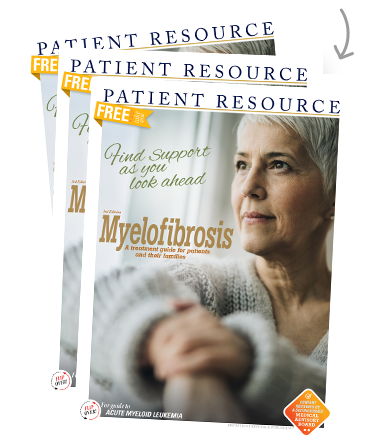Myelofibrosis
Supportive Care
The symptoms and side effects of myelofibrosis are unique to each person, making a personalized approach to managing them essential. As a result, you will work closely with a multidisciplinary health care team that will help you manage the disease so you can maintain a good quality of life.
Your team will draw on a broad range of services known as palliative care or supportive care. Palliative care is often confused with hospice care, but palliative care services may be used at any time during the cancer care continuum, while hospice focuses on end- of-life care.
Supportive care addresses the physical, emotional, practical, spiritual, financial and family-related challenges of people diagnosed with cancer and their loved ones.
Potentially Severe Side Effects
Though serious side effects are rare, they can occur with certain types of treatment. Ask your doctor whether you are at risk from the therapies in your treatment plan, how to identify the symptoms and when to seek emergency care. Report symptoms immediately if they occur so they can be treated promptly. Some potentially severe side effects include the following:
- Bleeding problems (hemorrhages) and bruising may occur. Inform your health care team about any history of bleeding problems, and contact them immediately if you experience any of these symptoms: blood in your stools or black, tar-like stools; pink or brown urine; unexpected bleeding or severe bleeding you cannot control; vomit that looks like coffee grounds; coughing up blood or blood clots; increased bruising, dizziness, weakness or confusion; changes in speech; or a long-lasting headache.
- Infection can occur as a result of a low white blood cell count (neutropenia) or other factors. Contact your doctor immediately – do not wait until the next day – if you have any of these symptoms: oral temperature over 100.4 °F, chills or sweating; body aches, chills and fatigue with or without fever; coughing, shortness of breath or painful breathing; abdominal pain; sore throat; mouth sores; painful, swollen or reddened skin; pus or drainage from an open cut or sore; pain or burning during urination; pain or sores around the anus; or vaginal discharge or itching. If you cannot reach your doctor, go to the emergency room.
- Tumor lysis syndrome (TLS) may occur after treatment of a fast-growing cancer, especially certain blood cancers. As tumor cells die, they break apart and release their contents into the blood. This causes a change in certain chemicals in the blood, which may cause damage to organs. There may also be worsening of your kidney function or an increase in the level of potassium in the blood. TLS can potentially cause damage to the kidneys, heart, liver or other organs. Symptoms may include vomiting, diarrhea, muscle cramps or twitches, neuropathy and decreased urination.
Some Common Side Effects
Supportive care often focuses on managing physical symptoms such as fatigue, weight loss, bone and joint pain, fever, rash, night sweats, gout, headaches, Graft-versus-Host Disease (GvHD), diarrhea, mouth sores, nausea and vomiting, and abdominal pain due to an enlarged liver or spleen.
Additional care will be needed for managing blood cell count levels, which are affected by treatment and the disease. Following are blood cell count issues that may develop:
- Anemia (too few red blood cells)
- Extra medullary hematopoiesis (production of blood cells in the spleen or liver)
- Leukocytosis (too many white blood cells)
- Thrombocytosis (too many platelets) or thrombocytopenia (low platelet counts)
- Thrombosis and thrombohemorrhagic complications (blood clotting or bleeding complications)
Managing Anemia and Fatigue
Myelofibrosis interferes with the development of healthy blood cells and frequently causes anemia. When someone is anemic, they do not have enough red blood cells to carry oxygen throughout the body. This results in symptoms of fatigue, shortness of breath, feeling cold and looking pale.
Regardless of the cause of anemia, your supportive care team will help you manage it. Therapies used include androgens, blood transfusions, corticosteroids, erythropoiesis stimulating agents and immunomodulators. In some cases, your doctor may recommend supplements to replace low levels of iron, folate or vitamin B12.
Other therapies for anemia are being researched in clinical trials. Ask your doctor whether you may be a candidate for one.
In the meantime, there are some actions you can take to ease the fatigue caused by the anemia. Tell your doctor if you are feeling weak and tired; get enough sleep; take a walk; eat a well-balanced diet; and perform activities that bring you joy.



